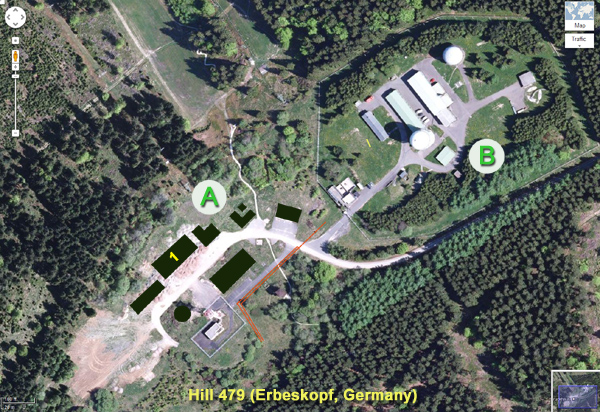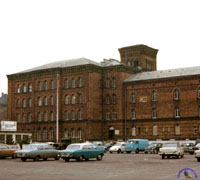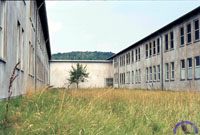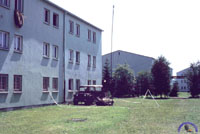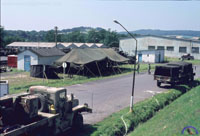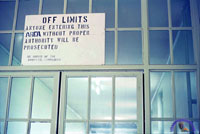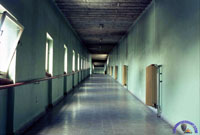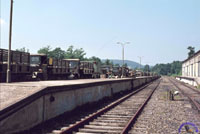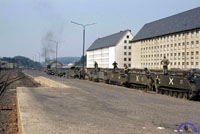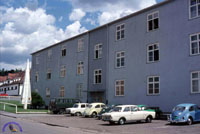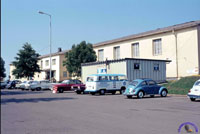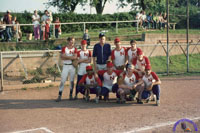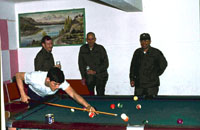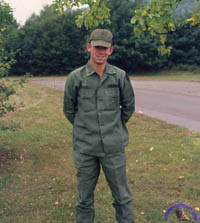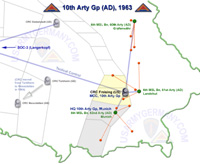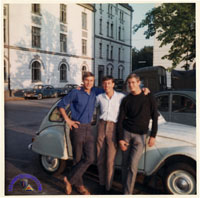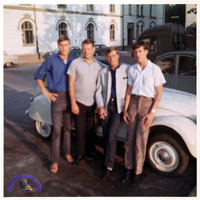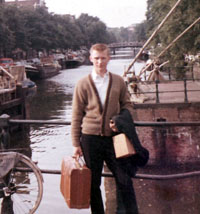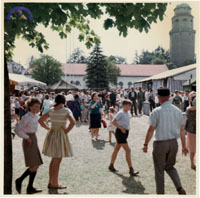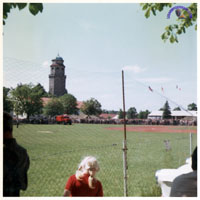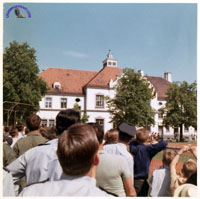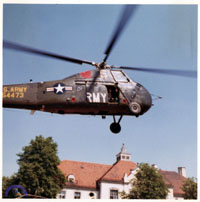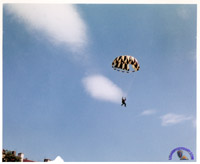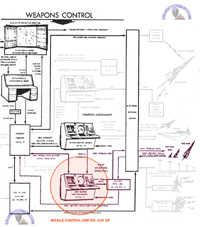| If you do
NOT see the Table of Contents frame to the left of this page, then
Click here to open 'USArmyGermany' frameset |
|||
|
Army
Air Defense in the European Theater |
|||
|
|
|||
|
|||
|
|
|||
| Manual System | |||
| 1940s-50s | |||
|
|
|||
| Semi-Automated System (412L) | |||
| 1960s-70s | |||
| Börfink MCC | |||
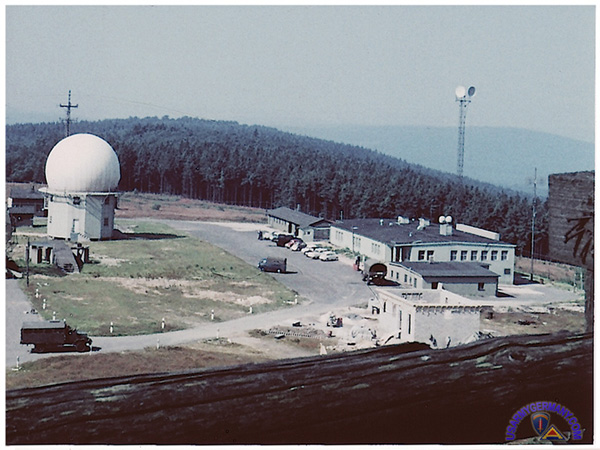 Erbeskopf (Hill 479), 1960s (Frank Fischer) |
|||
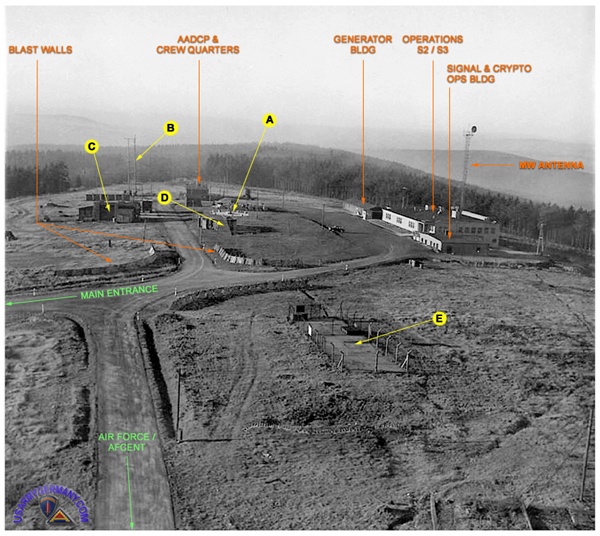 Erbeskopf (Hill 479) - AADCP Detachment, 94th ADA Group (Frank Fischer) |
|||
| (Source: Email from Vince Pfeiffer) | |||
I was assigned to HHB 94th ADA GRP Detachment from October 1974 to January 1977. Headquartered in Kaiserslautern, (K-Town), detachments were located in or around Birkenfeld, Neubruecke, Hill 479 Erbeskopf, and the bunker (Boerfink). There were both fond and somewhat not so fond memories of that experience. When it was good, it was really good, but when it sucked, it was indescribable; like a lot of guard duty, crazy shifts, and a lot of snow. The alternative was Nam, and in that light, it was always good in retrospect. As a radar repair technician; I was also cross trained to plot tell; target acquisition and assignment; to operate the RDPC (Radar Data Processing Center). The Baader-Meinhof terrorists were active during that time and bombed a facility in Frankfurt, and attacked some of our sites. We were one of the direct coordinating links between SACEUR, AFCENT, NATO, 4ATAF, which controlled Nike/Hercules, and Hawk battalions; including a number of German Hawk units. SACEUR commands were disseminated through us to all subordinate units. General Alexander Haig was the commander at the time. Along with target acquisition and assignment to line batteries, it also included passing that data to the 615th (AC&W Sqdn) for scrambling of aircraft to further coordinate and manage the necessary assets for any given target. We kept the codes that authorized arming nuclear missile. We issued all alerts from SACEUR, to all those attached forces in our sector. Ours was a multinational operation. We held many exercises at Borfink and Freising that ran mock soviet invasions. It was our duty to manage our assigned air defense forces. Occasionally, just for fun, we would input false tracks into the AF 412L system just to assess the scramble time for fighter craft on bogus targets crossing from the Soviet sector into NATO airspace. Of course they got back at us by doing the same thing but at a hundred fold. It is not easy to track and ID that many multiple bogies, only to discover they were fake. Many sleepless hours for line batteries having to come on line just to participate in inter-service rivalry games. It helped keep us all sharp. It was easy to get complacent in a darkened room, hovering over a data scope, while fading into zombie land after twenty or so hours of babysitting a scope with the same ho hum air traffic. The MCC (Boerfink and Freising bunkers) and the AADCP (Hill 479 Erbeskopf) were at separate locations. I had the fortunate opportunity enough to work at several of them. The 412L's were at Borfink and Freising. Our AADCP, the RDPC van, was a mobile version of the 412L. Regardless of who had operational command, whether the AADCP or in the bunkers, our mission was the same. We were a detachment of 94th HHB, under the 32nd. The AADCP generally did not perform the MCC operations, but could at any given time. The AADCP was more of the actual authority for SACEUR to command all forces in Europe. Whatever went to LIMA (Webmaster note: Boerfink Bunker) and its counterparts, came directly from an AADCP in one of the HHB grps It (MCC and AADCP) served a dual purpose. It was redundant in some respects, except all traffic came to us for dissemination. Without us, (on the hill), the bunker(s) would be blind. We all cross trained into many of the various jobs regarding command and control. That meant a lowly private could command everything except opening the code envelopes, which also required the officer on duty and the staff duty NCO (Two Man Rule). We all knew the Defense Readiness Plans (DEFREP) inside and out. We constantly tested ourselves on DEFREP regulations. The AADCP received info from radar data and transmitted it to the bunker. The AADCP, on the hill, could act independently if necessary, but not vice versa. The AADCP was the eyes and ears for the MCC. Although more primitive, the AADCP was a fully capable and functioning command and control facility. The one feature of all MCC bunkers was to withstand a direct nuclear blast. It would allow about twenty-four minutes, long enough to launch a multi lateral retaliatory nuclear strike. That, for all practical purposes would not have been possible from the AADCP in the event of a nuclear strike. Only those remaining units would have been able to strike back with certain codes that would have been issued in that event. Failing that, they would be able to only return an H/E missile. Autonomous operation was not available to any line battery. Without the correct codes issued by the MCC or AADCP, or without specific directives, any or all line batteries would go non op. The bunker at Borfink and Freising was connected to other MCC centers, which if still active, could take command and control from any other non-op MCC. The 412L was a multi IO (input/output) terminal that connected various components of command and control into one manageable system. Much like an air traffic control console, the 412L; in many ways it was used that way for target tracking. Multiple operators redundantly managing the same and adjoining airspace. Normally a single operator can manage all the control functions. During high traffic or exercises, there would be much more handling traffic. These were primarily bunker functions. The Air Force system was identical (to the AACP's system). We saw what they did and they saw what we did -- to a degree. Any terminal could perform any and all command and control functions. In its time, the 412L was a pretty sophisticated piece of electronic hardware. The 412 took the compiled data, presented it on screen into one comprehensive information center that allowed operators to track, assign, ID, or target any airborne object. System integration was rather impressive given the level of advancement of electronic and cryptographic data systems of the day. For example, the computer in the radar data processing center had a memory drum about eighteen inches tall and a diameter of about one foot. It contained 99 individual read/write heads that had to be individually adjusted, like the heads on an 8 track tape player. When the weather was really cold, it took a long time to send data down to the 412L. We had a direct connection to the bunker. We had signal and crypto outfits and AFCENT had their operations there also. We could communicate with practically anyone. The microwave repeaters allowed us to talk to other line of site command units. I helped some of the signal people align one of those microwave repeater horns one time during the winter of 1975, when they were short handed, and we were snowed in. I gained a healthy respect for those guys and their mission on that day. Climbing a tower in the snow and freezing cold is not very much fun. Climbing up into a radome from a small platform tower is one thing; but my hat is off to the personnel stuck with that duty. I thought thirteen hours of guard duty in a plywood shack with no heat was bad. At times like that, Viet-Nam seemed like a better alternative. |
|||
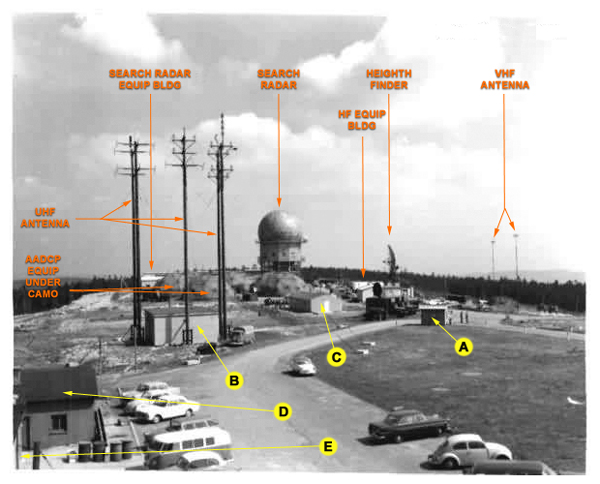 Erbeskopf, mid-1960s: AADCP vans and equipment are still under camo netting in the CRC area (Radomes website). |
|||
| Hill 497 (see annotated photo above): the site was rather substantial and housed an AFCENT unit, a signal detachment, a German contingent, and our detachment. We had an S-2 and S-3 office in the same bldg as the signal and AFCENT unit. There were three radomes, RDPC van, seven 400KW diesel generators, the AADCP bldg, separate from operations, support bldgs for the radomes, around (6) 2 1/2 ton trucks, a 5 ton tractor, several jeeps, a staff van, a few 1/2 ton pickups w plows. The AADCP was laid out similarly as the bunker but not as well organized. The signal detachment kept the comm tower, microwave, and crypto equipment going. We all shared the towers, two or three I think. I even helped them align the feed horns when they were short handed. That means I had the dubious honor in winter to climb those damnable structures to adjust alignment to towers on other hills...fun fun fun. All forces shared the assets and resources of the towers, including the AF. There was a German Ski lift at the back of the site, and a civilian observation tower at the front. Erbeskopf was a rather popular resort for skiing. The AF used the three radomes as a pylon and as a way to fly at ground level to get below them. They often turned sideways and flew in between the domes after straffing the site. I can tell you how impressive the intakes on an F-4 up close at speed, an how powerful the jet wash can be, after getting knocked on my ass a few times on a flyover; generally a daily occurance in good weather. They, I'm sure, thought it was pretty damned funny. Looking at the satellite view of the site (above), I see the site has changed quite a bit since I was there. The one thing still in the correct place, is the lookout tower (other side of the red lines that indicate the former perimeter fence) ( A ). It appears the entire site has been wiped clean. The radars are still there (in section "B"), one without a dome and the others back to the color white. They are still where they were, with support bldgs. The blast walls we built are gone too. The comm. tower and bldg forward is now completely fenced in (near the black circle). Bldg middle (indicated as "1"), was where our operations center was located and the housing for the signal unit. The AF and NATO units worked in the bldgs inside the section where the domes are now. It was not fenced in the same way it is now. The fence used to extend from the main road coming up to the site all the way around in front of A to the back behind A to the top right tree line. The bldg in the foreground by the comm. Tower did not exist. AADCP was in area "A". Amazing what 30 years will do. AF Tac and AFCENT lived and worked in the area where the Domes are located. Maybe the 615th. The German Tac Command was also in there, as well as some French and Belgian forces. I know because I pulled a lot of guard duty there. I had to ID everyone coming and going. I had to put a German Admiral and his aide on the deck face down for refusing to produce his ID. They arrived in a civilian car, in civilian attire. When I asked, the Admiral reached under the dash for something, I had no idea what, I pulled my weapon and put it to his head and ordered him out of the car and put him down on the deck spread eagle. They were not happy, I got yelled at, but later apologized to because I was following proper protocol, they were not. This was a top secret site, no way I was going to let him by without proper ID. Maybe that is why they changed the gate configuration. It looks like it has been separated from the other site now. The ski lift is still there I see. |
|||
| 1973 | |||
| (Source: Email from Bill Brandt, HQ 94th ADA Group, 1973-74) | |||
Google is rather amazing. I simply looked up "Borfink bunker".
I was one of the last of the draftees, being inducted Sep 1972. There was only one group after me - in Dec I believe - ever drafted.
Upon completion of my basic training at Ft Ord, the Army put me into a program I didn't even knew existed - Army Air Defense.
Apparenty it is the last vestige of the old Army Air Corp, everything else being turned over to the Air Force in 1948. I believe every other military in the world has their ground to air defense with their air forces.
However being an Army unit the Air Force naturally wants to know if we may want to shoot down one of their planes so we (and every command unit of Army Air Defense as far as I know) works with a unit of the US Air Force.
After training at Ft Bliss TX I was sent by a bit of bureaucratic fate to Germany - 3 of us out of our class of 35 were sent to Germany; the others to Korea.
Originally the civilian bureaucrats didn't know what to do with 5 of us out of the class so we 3 kept bugging the bureaucrat until he finally said on the 3rd day "OK we'll send you guys to Germany".
The remaining 2 stayed in El Paso (Ft Bliss) and showed movies and emptied ash trays for 2 years.
My original station with the 94th Group under the 32nd ADA was at an old radar station overlooking Ramstein AFB by Landstuhl.
We lived on the base of the Hospital at Landstuhl in an old (condemned) Luftwaffe barracks. The foundation was crumbling and you could put a ball on the floor and watch it roll on its own. It was built for maybe 1,000 personnel and held 30 of us Army people.
From the radar station we had quite a vew of Ramstein - one could see the entire huge runway and I remember seeing the (then) new C5A and F15 on approach. The C5A seemed to float forever; the F15 was powder blue and was being flown to show the air force units what was coming.
However the equipment there was ancient (most from the early 1950s) and so unreliable we got feeds from the Borfink bunker.
I felt as long as I am here I might as well do something meaningful so I volunteered for Boerfink, which was code named Lima.
It was like a mini NORAD and run with a lot of seriousness and discipline. Our (Army's) job was to coordinate communications among our HAWK and NIKE missile bases around Germany.
Someone had to be on the dias 24/7 and run communication checks every 2 hours. I spent many a night at 0200-0600...there were 2 hour shifts.
You would usually pull 2 shifts in a 24 hour period - then take the Air Force bus back to our barracks at Neubruecke to sleep (during the day). One got a feeling like Dracula entering the bunker in the morning, living in darkness for 24 hours, and leaving in light.
When I got to Lima we had 24 on and 72 off which was pretty nice but over time due to manpower shortages we went to 24 on and 24 off.
At Lima we worked with US Air Force and German Luftwaffe personnel. It was here that I got the "dubious" distinction of attaining the nickname "Bratwurst" because I liked the German snack bar. Hey would I tell the world this fact if it weren't true?
I spent a lot of time at Trier, an old Roman city along the Mosel, and Bernkastel before it really became a tourist destination. Places like Idar-Oberstein and Landstuhl bring back nice memories. Riding on th Kohn-Dusseldorfer boat up and down the Rhine....
Thanks for the memories... ADDITIONAL INFORMATION I forgot to mention in my post - and not mentioned - we also controlled a German Nike site - although where it was I cannot say - I just knew it by numeral designation. Since I spoke passable German when we would order them to a certain readiness state and they pretended like they "nicht verstehen" or "no habla" they would send me down to the dias and with my understandable but funny German I could hear laughter on their end.
I went back to Germany 20 years later (1992) and stopped at my barracks at Neubruecke - couldn't believe I lived in such a slum! I drove up to the bunker - met a young German guard and of course I wasn't allowed entrance - even for old times sake - but he said that it would be closing in a couple of years which it did (by your excellent web site)
I have plenty of slides - I want to get a Nikon slide copier that converts them to digital images - if you want some pics I will keep your address - should have something in 6 months (it is $600) Of course I have none of the bunker but my barracks - and the Air Force bus we knew so well...
I have just scanned some of my Europe black and white pictures and will include one of the Neubruecke hospital complex - it was 1973 and at the time the coldest winter in 200 years I think - the hospital was closed but we had our barracks and mess hall.
|
|||
| (Source: Email from Michael Reed, 94th Gp MCC) (Webmaster Note: Mike's email was from 1999. In the meantime I have lost his email address. Does anybody know how to get a hold of Mike?) |
|||
| The 94th Arty Group Missile Control Center (MCC) was technically an Army Air Defense Command Post (AADCP), but we weren't normally referred to as one. A typical AADCP was a semi-mobile unit, like a missile unit. We were a permanent installation, housed in an underground bunker. We did have an Alternate MCC on Hill 479 that was referred to as an AADCP because it was mobile. The mission of the MCC was the same as an AADCP, however. The MCC was part of Sector Operations Center 3 (SOC3) rather than the Air Force Control and Reporting Center (CRC), I believe. Though we were located in the same building as the CRC (operated by the 615th AC&W Sqdn), we would only come under the same commander during tactical operations. The missions may have been coordinated through the SOC. We were separate entities during normal operations. The organization of the 94th Gp MCC was pretty simple , since it was a fairly small unit. It was commanded by a Col or LTC, and had four crews. Each crew had a captain as a crew leader, a SSgt as a crew chief, and four to six crew members. The MCC was responsible for four US Nike Herc battalions, one German Nike Herc battalion, a US Hawk battalion (from the 10th Gp, I think), and a loose association with a US Chapparal/Vulcan unit. The Börfink Bunker was an underground installation which housed the 615th AC&W Sqdn and the 94th MCC. The installation commander was of the CO of the 615th, and the bunker facility was maintained and guarded by German civilians. Börfink did not have its own radar. The MCC used processed radar data supplied by the 615th. Though we had access to raw radar images, we only used processed data. The radar data came to Börfink through a network of radar sites throughout Germany. Troops were billeted in Neubrücke, which was also commanded by the same Air Force commander, and were bussed to the bunker. Börfink didn't have any of its own support facilities. It was a self contained facility that could survive a direct hit from a medium yield air burst nuclear attack and provide a livable environment for all of its occupants for several weeks. The mission at the MCC during normal peacetime operations was to monitor and assign status levels of each fire unit under our control. Status levels determined how long it should take a unit to be ready to engage a target. I don't recall the particulars about status levels, but I think a 'Status 4' was the highest peacetime level a unit had to maintain, and only one battery per battalion was required to maintain that. If a unit lost a piece of equipment that affected its status level, then we would instruct another unit to increase its status. We also performed commo checks with the BOC of each battalion as well as computer intergrations to insure that our weapons control systems communicated properly. The tactical mission of the MCC was to provide centralized control of the air battle from our weapons distribution consoles. The MCC had a console assigned to each BOC and was manned by a Missile Assignment Officer (MAO). Each MAO had an NCO as an assistant MAO. A master console was manned by a Senior MAO. We also provided the BOCs with early warning intelligence from a seventh console. These consoles were located in a room about the size of a small theater. The Air Force CRC was also located in this room. The MAOs assigned targets to the individual fire units via the BOC. A senior MAO assigned targets to each MAO for engagement. If any BOC lost its comm links with the MCC, they would then go on autonomous control. The MCC also provided early warning info to the BOCs as well as EMAS messages. Orders from the MAOs were communicated to the BOCs from the consoles by pushing various buttons. No voice communication was necessary if the system was working correctly. If the system broke down, the BOCs were capable of conducting the air battle autonomously, as was each individual fire unit if the BOC went down. The only problem would be either multiple engagements or some aircraft getting through without engagement. As far as receiving orders from any higher levels of command, I think the tactical orders originated from us, based upon the tactical situation. Any operational orders probably came from 32nd ADCOM. I don't recall receiving orders from SOC3, but I do recall submitting unit status reports and ECM reports to SOC3, though I'm sure we passed on more than that to them. I don't recall interfacing with any other MCCs. We were, however, in very constant contact with 32nd ADCOM. It is my recollection that all intelligence to and from the battallions came through the MCC and the next level of contact was to 32nd AADCOM, though some types of information was passed on to SOC3. I don't recall passing any intelligence to 94th Gp, except maybe monthly summary reports. NOTE: In discharging the responsibility for directing air defense, the CRC detects and identifies hostile airborne objects, recommends changes in air defense warning conditions, specifies weapons status, and scrambles or diverts air defense capable aircraft. During joint operations, the CRC assigns appropriate hostile airborne targets to the Army Air Defense System through the Army Air Defense Artillery Fire Coordination Officer located within the CRC. |
|||
| 1981 | |||
| (Source: 32nd AADCOM The News, Special Orientation Edition, October 1981) | |||
| 'Invisible' units protect skies By Hal Leathers Sometimes forgotten by air defenders at the line batteries, the Boerfink and Lauda-based Missile Control Centers (MCCs) perform a "middleman" role between the North Atlantic Treaty Organization (NATO), Fourth Allied Tactical Air Force (4ATAF) and the four 32d AADCOM Group Operations Centers (GOCs). Responsible for the control communications and the operation of 32d AADCOM's air defense missile deployment, the MCCs have a constant 24-hour, round-the-clock mission. Working directly under the control of 4ATAF, the Boerfink MCC has operational control of the Nike-Hercules and Hawk missile systems from units in the 94th and 108th Air Defense Artillery Groups. The Boerfink operation is directly responsible for control of medium and long range missile air battles, the only dual MCC in 4ATAF. Lauda operations handle medium range HAWK missile employments for the 10th and 69th ADA Group line batteries. Boerfink-based ADers work directly for the Air Force with the 603d Tactical Control Squadron out of Sembach Air Base, presenting a different working arrangement. "We have an outstanding working relationship with the Air Force people. They help us with just about everything and we try to explain the difference that sometimes exists between Army 'lingo' and the Air Force way of doing things. It is a good relationship," said Capt. Richard Lavoie, Boerfink crew officer-in-charge. Evaluated and checked like any other ADA operation by 4ATAF, the MCCs provide liaison with their NATO counterparts. The MCCs often times are put under strenuous evaluation to test their skills at missile allocation, control, assignment or management. Soldiers with air defense military occupational skills who man the MCCs put in long and hard hours, not only in front of a scope but in checking manuals and becoming familiar with the NATO way of doing things. "We have a demanding job," noted one soldier at Boerfink," and maybe we do go unnoticed, but we know we provide a vital link in air defense - and that is important!" |
|||
| Freising MCC | |||
| 1950s-early 1960s | |||
| ARMY AIR DEFENSE AND 412L (Source: Donald P. Moriarty, II, 10th Arty Gp and 6th Msl Bn, 61st Arty, 1962-65; 32nd AADCOM, 1973-77) |
|||
| I had two tours in 32d AADCOM, the first from Sep 1962 to Aug 1965; the second from Sep 1973 to Aug 1977. I served with HQ 10th Gp., with 6/61 ADA, and at the command HQ. In both cases, my time at HQ 32d was in the G-3 Plans Division. After that, from 1977-80, I was assigned to the Directorate of Combat Developments at USAADS as chief of the C3I department, with emphasis on interoperability. In that capacity, I was the US Army rep to the Tri-Service Group on Air Defense at HQ NATO, Brussels. This is the body which created the common tactics and operational procedures for all NATO military forces (we wrote the doctrine that AAFCE and 4ATAF implemented). So, in all, this became my specialty for 10 years of my 25-year career. |
|||
|
|||
| PART 1 (1962-65) As you know, HQ, 10th Artillery Group was activated 1 July 1960 at Munich; the headquarters were located at Will Kaserne on the north side of the city. In July, 1962, I was sent to the GE factory at Electronics Park, Syracuse, NY, to be trained on the Army Weapons Console of the 412L system then being built there, with further assignment to HQ 10th ADA Gp. On arrival in Munich in September, I was assigned to the operations center at Freising. The group¹s Air Defense Command Post (ADCP) was based at Vimy Kaserne in Freising, on the Isar River northeast of Munich. In December 1961, 6/61 ADA was deployed to Germany and assigned to the 10th Gp., along with two additional battalions. Therefore, by 1962, MCC Freising controlled (manually) the group¹s three Hawk battalions: 6/60 ADA (at Amberg?), 6/61 ADA (at Landshut), and 6/62 ADA (at Dachau). Beginning in 1960, the USAF had sought approval for a new Air Weapons Control System, the 412-L system. The 412-L was approved not only by US authorities, but also by NATO, and was ultimately integrated into the NATO Air Defense Ground Environment (NADGE) System. During 1961, construction began on two very large underground bunkers, located at Boerfink and Freising, with a similar, but above ground structure at Giebelstadt (cost overrun). These bunkers were 4-story structures with walls 14-feet thick and buried beneath 24 feet of packed earth. This was the peak of the Cold War, and these structures were the state of the art in nuclear survivability (we quietly overlooked the fact that one infantry platoon which occupied the ground overhead could neutralize them). By late 1962, 412-L electronic equipment was being installed in the bunkers; Giebelstadt was the last to become operational. This combined force system included radar control and surveillance consoles, as well as air weapons and army weapons control consoles. By this means, the separate (manual) air control and warning, interceptor control and missile control operations were fully integrated and used a common digital data link at all echelons above battalion for the first time. The 32d AADCOM¹s 11th Signal Battalion continued to provide the army¹s unique digital data link from groups to their respective battalions and thence to the firing batteries. Beginning in 1964, German Air Force Hawk battalions, trained at Fort Bliss, began to arrive in country, and initially were deployed to replace the French Hawk battalions in the region south of Munich, and which would be withdrawn in the 1966 timeframe. Increasingly, throughout the '60s, the operational concept of Allied Command Europe became focused on "mobile defense" which required a closer alignment of ground and air defense forces. These operational concepts, plus the German Hawk deployments, were to result in a massive realignment of the US ADA force structure. During the period 1969-70, four selected Hawk battalions (1/1 ADA, 2/2 ADA, 3/7 ADA, 3/60 ADA) were converted to a self-propelled configuration to provide additional mobility and better support to the maneuver forces with whom they were paired; two of these SP battalions were assigned to 10th Group. During the period 1972-76, the remaining battalions were converted to the Improved Hawk configuration. In 1964, HQ 10th Group was relocated from Munich to Darmstadt to be within the V Corps tactical zone (69th Group was already within the VII Corps zone); the vacated region south of Nuernberg (III Corps) was now covered by German Hawk battalions of the 2d Luftwaffendivision. Therefore, by 1966, 10th group had four Hawk battalions in an entirely new area of responsibility: 1/1 ADA (SP) (at Wildflecken); 2/2 ADA (SP) (at Giessen); 3/59 ADA (IH) (at Hanau) and 2/62 ADA (IH) (at Spangdahlem). With this redeployment, the group¹s MCC was relocated from Freising to Giebelstadt. In June, 1963, I transferred from HQ 10th Gp to 6/61 ADA, to become battery commander of C/6/61 at Ingolstadt. At that time the Bn HQ and BOC were at Landshut; (I forget where A btry was); B Btry at Landshut; C Btry at Hepburg, just outside Ingolstadt; and D Btry at Regensburg. During my 14-months there, we paired with a German Hawk battery for some six months, the Americans staffing one fire section, the Germans staffing the other. We had a total integration within the battery (they used our equipment as theirs had not arrived from Bliss) and an excellent relationship, with one exception. During our annual FTX, when the battery was deployed in a strictly graded and tactical situation (light and sound discipline at night, aggressors, etc.), the Germans got restive at the "games", built a big bonfire, broke out the beer and had a rousing song-fest (all the old marching songs). The aggressors piled on us like flies (as did battalion and group staff) and it took some three cases of beer to bribe everyone off (US and German) and get everyone to go to bed. In August, 1964, I moved to HQ 32d Brigade, to the G3 Plans and Operations Section. MG Richard T. Cassidy was CG; Colonel Tom Chavez was Deputy; Maj Lee R. Smith was G3. The headquarters was located at Kapaun Barracks, Kaiserslautern. The major actions at that time had to do with getting increased force structure in the brigade (increasing the TO&E authorizations); getting additional NATO real estate for battery tactical sites (several batteries had no permanent tac sites); and completing weapons deployment in the Nike Hercules units. In August, 1965, I rotated out, bound for the Artillery Career Course, to be followed by the 1st Cavalry Division DivArty in Viet Nam. |
|||
| PART 2 (1973-77) In Sep 1973, I returned to HQ 32d AADCOM and inherited the results of many of the actions I had undertaken during my first tour there. MG Thomas E. Fitzpatrick was CG (18 Jul 1973 - 1 Aug 75). BG Robert Lunn was deputy. For the first six months, I was an Asst. Community Commander (the CG was Community Commander, Kaiserslautern). The military community included some 14 kasernes, to include Landstuhl Army Hospital. It was a necessary, but thankless, job and I was happy to see the end of it. In March, 1974 I became the chief of G-3 Plans and moved back to the same office and the same desk I had occupied nine years earlier (some of my old staff actions were still in a bottom drawer of the desk). While in that capacity, USAREUR did a complete revision to the war operations plan for the corps (MG Don Starry was at V Corps and sparked this). We published a commensurate revision of the 32d AADCOM war operations plan which married 10, 69, and 108th groups closer to their respective ground combat units than ever before; as well as a HQ Deployment Plan which defined the wartime mission and functions of HQ 32d AADCOM as a major command of USAREUR and of 4ATAF (this had previously been a very nebulous area). During this time, we also planned and executed the relocation of the HQ (to include 11th Sig Bn) from Kaiserslautern to Darmstadt in the February 1975 timeframe. On 1 Aug 1975, MG Fitzpatrick departed the command, succeeded by MG Robert W. Fye. We continued the operational integration effort, with emphasis on a closer relationship with the German 2d Air Division. This organization held a position similar to 32d AADCOM, in that it was also a major command of 4ATAF and paired with HQ III Corps in the region from Nuernberg to Bad Toelz. In Aug 1977, I rotated out to USAADS at Fort Bliss. PART 3 (1978-80) Early in 1978, I inherited primary responsibility for interoperability of AD forces. This had two main aspects: integration of US land forces (focused on digital data systems and C2I integration); and integration of NATO forces. As a member of the NATO Tri-Service Group on Air Defense (AC 280), we finally finished acquiring real estate so every battery could have a NATO standard permanent tac site; planned the deployment of the AWACS and AN/TSQ-73 systems; began deployment planning of the Patriot system (then, still SAM-D); and resolved many of the operational inconsistencies which had bedevilled mobile Hawk commanders in the 4ATAF area. I made monthly trips to Brussels to the NATO meetings there (sandwiched by pre-briefing plus de-briefing stops in Washington), to the extent that for four years I averaged 20+ days per month on the road. This is a rotten situation for good family life. However the company in Brussels was wonderful, and to this day I maintain that HQ NATO is "the last bastion of gentlemanly diplomacy". It takes forever to get something done but, if you can stand the everlasting delays, it can be a remarkably satisfying place to be. This was undoubtedly the high point of my entire career. I retired 30 Nov 1980. |
|||
| Giebelstadt MCC | |||
| 1966 | |||
| (Source: Email from Don Hanset) | |||
| I was in the U.S. Army from January 1966 through May 1969. I was stationed in Wurzburg, Germany from 1967 until my discharge in 1969. I was within the 32nd Army Air Defense Command and the 69th Artillery Group (Hawk SAMs). I was assigned to the Hawk Missile Control Center (MCC) within the U.S. Air Force Gibelstadt 412L facility.
I worked there through about the end of 1968 and transitioned to the new underground site at Lauda-Königshofen until my time in the service was up. Our purpose in the MCC was to ensure that data gathered by the linked 412L sites was transmitted to our Hawk missile sites. The data augmented the short range data provided by the Hawk missile sites own radar. I can remember that Cabinet 56 was the physical cabinet in the computer room that transmitted the data to our Hawk missile sites. A GE contractor, Don Basic, provided support to the Giebelstadt facility. I remember being amazed at his knowledge of all the systems. My time at the 412L site sparked my interest in computers which became my profession after I left the Army. It's been a long time but I'll try to describe the layout of the Giebelstadt radar site. There was a large Quonset hut kind of a building that housed the U.S. Air Force "control center." I believe the building was on the south side of the runway which I think was about 10,000 feet but used only by a local German flying club. Our 69th Group MCC was in the back of the room on a kind of balcony. We had about 5 consoles that could display the radar data available (from what I seem to remember as 5 linked Air Force sites) and we maintained a manual status board reporting on the 5 Hawk missile battalions with 4 batteries each. We could talk over phone line to each of the battalions and batteries. In the basement was the 412L computer. Outside the main building were the radars (all under domes) and some smaller buildings. Our 69th Group MCC had a small administrative office in one of those buildings. At the east end of the runway were some Air Force facilities which I do not remember very well. I do remember getting haircuts there and there was a swimming pool. Everything was above ground and on occasion we could tell that the Eastern bloc countries knew just where we were. We figured we'd last about 60 seconds in time of war. After the move to Lauda we figured we'd last as long as our water and food held out or we were rolled over by ground forces. We did not control German Hawk units. If fact, I don't remember being aware there were any at the time. Our group pretty well covered the eastern border of Germany from Austria to about the latitude of Frankfurt. I would think there must have been SAM sites north of our coverage but don't remember now. |
|||
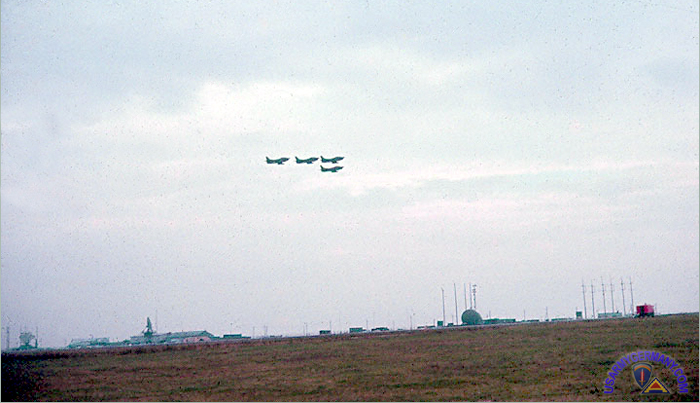 Giebelstadt Radar Site, early 1960s |
|||
| The picture you have (above) is interesting. I don't really see a small "outbuilding" the would have been our office. Looking at Google Maps now it looks like the whole complex was torn down at some point. And I'm amazed at the solar panel complex there now on the north side of the runway. And looking at the Google Map picture I believe I may see the signs of a Hawk missile battery north of the east end of the runway. The picture brings back three other memories of the runway. One is that we had a (I believe) CANBERRA bomber with a DC power failure circle the runway for awhile burning off fuel thinking they would land but they decided their chances would be better at a "real" airport so went somewhere else. The second is a German F-102 STARFIGHTER landing with a problem of some kind and running off the end of the runway (at 10,000')! And the last is a small single engine plane running into a car on a taxi way / road at the east end of the runway and leaving the prop embedded in the passenger door of the car. Our 69th Group HQ was in Emery Kaserne in Wurzburg. I spent only a little time there since I was assigned to the MCC. Also, somewhere in Wurzburg the 69th Group had a Raytheon AN/MSQ-56 system comprised of three "semis" - one had a radar dish, one was a processing center, and one had display consoles and communication equipment. We would occasionally "fire up" this system to see if it still worked (my words). It was a tube based system and supposedly mobile. Sometime toward the end of my tour (maybe early 1967) the 69th Group commander decided we ought to test out the mobility part. After moving it the system did not come live again while I was there (through May 1967). There were only 3 of these systems - ours in Wurzburg, one at Ft. Bliss for training, and one in Korea so parts and expertise had to be scarce. It would be interesting for me to get in contact with Don Basic, the GE technical support person I mentioned in my first e-mail. |
|||
| Langerkopf MCC | |||
| 1950s-early 1960s | |||
| (Source: Email from Roger Williams, MCC Langerkopf and MCC Freising, 1964-65) | |||
I was initially stationed in Pirmasens, Germany from August 1963 to January 1964 with 2nd Msl Bn, 56th Arty prior to going to Langerkopf. This was a Nike Hercules unit. We ran many a drill there which I was soon to find out was directed by Langerkopf. Missiles were above ground, on rails. Guard towers circled the missile compound (four). The missile fire bunker location was within the compound above ground. Very small bunker containing double bunks for four, and the firing control unit next to the door. Got hotter than H.. in there. No ventilation. The guards in the Towers were relieved by the soldiers in the bunker I believe every two hours. The Ready Building was located just outside of the missile compound area. There you would eat, relax, and wait your turn to relieve those inside the compound. The main base was down the mountain from the missile site. Probably a ten minute ride in a 5-ton truck. Thats how we were transported to and from the Nike site. No good memories from this assignment. I was stationed at Langerkopf MCC (Air Force & Army) and worked there from January 1964 to February 1965. I believe the French were taking over Langerkopf soon after I left.My job at Langerkopf was to monitor aircraft on radar and to also have the missile batteries run drills. The brass sat directly behind us in a glass enclosed area (see photo from S&S article). A couple of times it was necessary to fill in for the Air Force and work behind the large clear aircraft plotting board. Amazing how quickly you can learn to write backwards. I must say though, I am glad I only had to do it twice.
The duty was great at Langerkoph. No KP, no formations or inspections. Everyone knew their job and did it well. Lots of time off to travel and see Europe.
The job was unsually routine until one day in March 1964 when we plotted one of our aircraft approaching the border of Soviet territory (East Germany). Our aircraft crossed over the border.... and was soon joined by Soviet aircraft. Our aircraft was shot down. I never heard anymore about the incident after that day. I recently saw on the Internet the three airmen survived. Thank God. I also read were a similiar incident occurred in January 1964, about a month or so before I arrived at Langerkoph. The three airmen in that incident were killed when the Soviets shot down their aircraft.
Freising MCC I was the only one (Army) from Langerkoph that was sent to Freising around the end of February 1965. I have no idea where the other guys were sent. There may have been Air Force personnel from Langerkopf sent to Freising too, however, I would not have known that due to the Air Force and Army always being housed in separate areas and leading separate lives.
The MCC at Freising, Germany was a nice base. A very large base. Each military group (US Air Force, US Army, Germans, French) had their own barracks. Myself and a Sp.5 had our own room in the (U.S. Army) barracks (Webmaster note: Vimy Kaserne, Freising). The town of Freising was small but nice. I found a nice restaurant and also a gasthaus that I visited quite often. A couple of German soldiers from the base, myself and another American would hang out together in Freising and nearby towns (they had a car). In April 1965 we studied the new 412L radar system, took a test, passed, and were issued a certificate.
In August 1965 I left Freising and was flying back to the States for separation from the service.
Note: I have wondered what became of those who I served with at Langerkopf and Freising. I guess we should have exchanged home addresses.
Sad Note: I had a "Langerkopf beer stein" (broken). It was beautiful. It had a pewter lid with a plane on top. It also had a picture inside on the bottom that you could see if you held it up to the light. |
|||
| ADDITIONAL INFORMATION Q: Where was the MCC group was located within the Langerkopf CRC Operations Room? We were facing the big plotting board and located all the way to the very back. You had to go up about four steps to reach the level we were located. The command staff was located in a room directly behind us. The room had a large glass window that ran the full length of the room which gave the command staff a full view of the operations. You have a picture where the command staff sat on your website. Q: How large was the MCC? The MCC center really wasn't that large. I don't think it was more than 30 ft wide by 50 ft long. But as I said its been over 40 years.We worked shifts. I think it was three guys (maybe four) on each shift. I think we only had a couple of scopes. I remember one or two guys would be watching the scope while two of us would be playing a game of chess (break time between watching the scope). |
|||
| Lauda MCC | |||
| Late 1960s-1980s | |||
| (Source: Email from Timothy P. Doyle, MCC, 69th ADA Gp, 1977-79). | |||
| I was assigned to HHB 69th ADA Group Emery Kaserne in June 1977. My MOS was a 16H10 ADA Operations & Intel. Assistant. My duty assignment was to the Missile Control Center in "The Bunker" (Codename: GUSTAV) in Lauda, FRG. Our Baracks were located just outside of a Bundeswehr base know as Deutsch-Ordens-Kaserne, Bad Mergentheim, FRG. There were approximately 30 to 35 US Army Officers & Enlisted assigned to the MCC. We were the tactical operations and control element of the entire 69th ADA reporting to NATO SOC. We worked side by side with a German Luftwaffe Tactical Fighter Control Unit (Webmaster note: the German unit was designated as "II. Abteilung, Fernmelderegiment 32") which also fell under a NATO SOC Command. Together we were responsible for the air defense of Central Europe and the Fulda Gap. Col Hoey and Col. Sugimoto were the two 69th Group Commanders during my tenure at the MCC. I served under LTC Moser and worked directly for Maj. Richard Black, the BN XO when I was at 3rd/60th in Graf. He was the best officer I ever came across during my service. He later became a General and I'm sure is retired by now. Our place of business was a "Nato Secret" Bunker built into the side of a hill similar to a NORAD facility. Tracking hot Soviet airborne targets, conducting simulated war games and tactical evaluations of our subordinate units was the cold war orders of the day. The IHAWK systems were updated at the time and the command and control systems were fairly new. "The Bunker" control room was like a scene out of NASA Houston only dark and quiet. SAMA was the top dog for missle control. The outlying battallions, 6/52, 2/57, 3/60, 3/7 and their batteries were under our direct control. I can still see the baby blue colored NATO SECRET COM4ATAF Air Defense Manual in my minds eye. We had to study it and the never ending revisions continuously in order to remain at the top of our game and pass our tactical evaluations. There were quite a cast of characters manning the operation but most were professional, conscientious and intelligent soldiers. Although we were considered "isolated," the duty was unbelievably good as ADA assignments go. The surrounding area was rural for sure, but with enough to see and do to keep me busy. I was fortunate to serve with a great group of guys. I can still remember many of their names: Joe Ricker, Jim Lawrence, Abe, Radar, Gary Green, Pop Krukenberg, Israel Cooper, Dap Daddy to name a few. Kapus was the former POW Polish cook and the security force that guarded the facilty were also German prisoners during WWII. Taxi Lubo was the transportation/civilization lifeline to and from the Milk Bar, the Vesperstuble and Bobstadt the local disco. Beer was the glue that held everything together and the local German people were a never ending source of entertainment. Ingrid, Elke, Ushi and even Frau Lubo all had our numbers and I'm sure were as entertained by us as we were by them. In 1979 I had a major disagreement with the OIC and was transferred to the dreaded Grafenwoehr (Training Area) were I spent the remaining 18 months of my active duty time. I invite any of my partners in this unique experience to contact me at my e-mail address. In the meantime I'd like to quote Rick Webb who hated every minute of his duty there: "This is Tim Doyle, CBS News, Moscow! |
|||
| ADDITIONAL INFORMATION: The MCC was a detachment of Headquarters and Headquarters Battery, 69th Group. The MCC was organized into shifts. Personnel assigned to the MCC were primarily Missile Control or Communications. Mostly 16H4. |
|||
|
|||
| Wasserkuppe MCC | |||
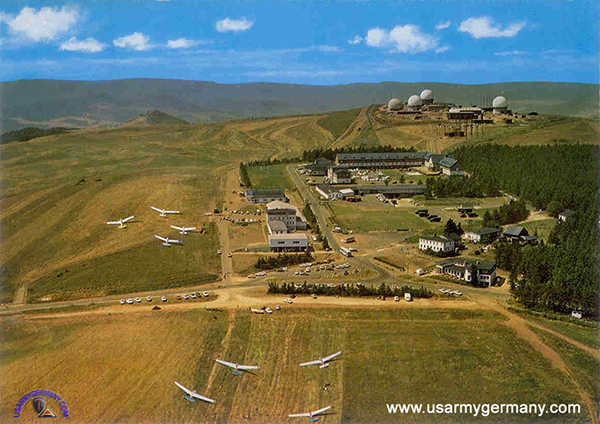 Undated postcard showing Wasserkuppe Air Station with troop area and technical area |
|||
| 1971 | |||
| (Source: STARS & STRIPES, April 6, 1971). | |||
| 10th Arty Gp operates a Missile Control Center at the Wasserkuppe Radar Site. The MCC is staffed with 18 personnel. Colocated with the Air Force's 616th Aircraft Control and Warning Squadron, the MCC uses radar-computer equipment (412L AWCS) to link to 14 (HAWK) missile batteries along the border. | |||
| 1976 | |||
| (Source: Email from John Oravis) | |||
| HQ 10th ADA Group operated a small Missile Control Center (MCC) (“Cricket Lima”) at the Wasserkuppe Air Station. It was co-located with a fixed, above ground USAF 412L Control and Reporting Post (CRP). Wasserkuppe was nearly 1,000m above sea level. There was also an Army 11th Signal Battalion relay site (T-52?) and detachment at Wasserkuppe.
I was reassigned there in May 1976 from B/1/1 in Wildflecken. MAJ Jerry Donohue was the Army OIC and the only other officer at the MCC at that time. The Army MCC element had 2-3 scopes/consoles with communications for that purpose. By the time that I was reassigned there in mid-May 1976, the Army element had attrited to ~6-8 personnel, including one field grade officer (OIC) and one Operations Sergeant (E-7), and several enlisted personnel. I don’t know if that was by design or chance, since the decision to close and move the MCC element to Griesheim occurred three months later. By then, I lived on the economy in Wildflecken and made the drive to/from Wasserkuppe every day. (I finally received a DA-funded PCS move from Wildflecken to Darmstadt in Spring 1977). I can’t remember the details about the 2 Army captains that had attrited, but I believe they also commuted from Fulda. I can’t speak for the 11th Sig Bn detachment personnel, but I think there were only 3-4 of them, maybe fewer (that’s a rough guess). They probably lived in the USAF billets at the Wasserkuppe. I think the Army MCC element had one jeep w/trailer and a 4-drawer safe for classified documents. It had a small dedicated office for admin/operations and the OIC. During the summer of 1976 when the 412L site went down for scheduled deep maintenance. 10th ADA Group (commanded by COL Eugene Fox) moved its personnel and ADA command and control functions from Wasserkuppe AS to Griesheim AAF, near Group Headquarters at Ernest Ludwig Kaserne, Darmstadt. |
|||
| Related Links: |
|||

